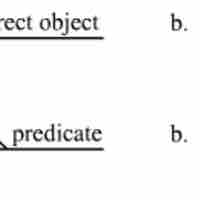Chapter 4
Overview of English Grammar: Parts of Speech
By Boundless

English features four core sentence elements (subjects, predicates, objects, and modifiers) that make up phrases and clauses, which in turn make up sentences.
Different types of sentences are used for different purposes and in different parts of a paper, but the foundation of all good sentences is a strong subject and verb.
In the context of grammar, inflection is altering a word to change its form, usually by adding letters.
Verbs are crucial to expressing a sentence's meaning, so it is important to use them correctly.
Verb tense indicates whether the action of a sentence occurred in the past, present, or future.
"Aspect" refers to whether a verb is continuous, completed, both continuous and completed, or neither continuous nor completed.
Grammatical mood is a verb feature that allows speakers to express their attitude toward what they are saying.
Adjectives modify nouns and pronouns; adverbs modify verbs, adjectives, and other adverbs.
Adjectives modify nouns and pronouns.
Adverbs modify verbs, adjectives, and other adverbs.

A modifier is a word or group of words that describes another word or group of words.